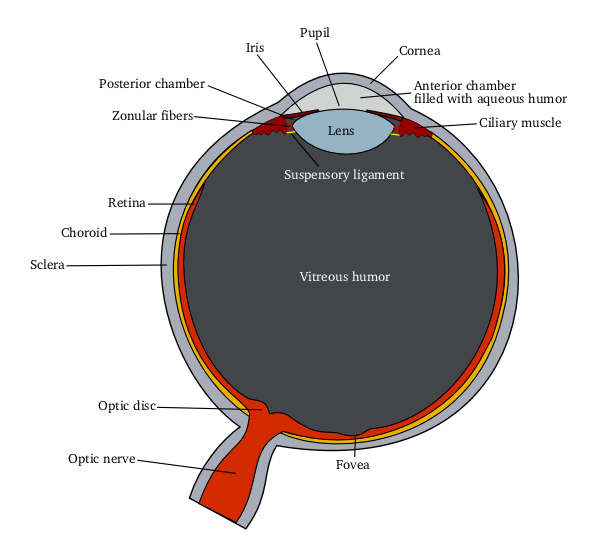


The fixed membrane that covers the IRIS and the pupil, and provides the primary means of focus. The curvature of the cornea is fixed.
The malleable, convex membrane that helps focuses light on the RETINA. The curvature changes for fine focusing, making small changes in the FOCAL LENGTH of the eye’s optical system.
The collection of muscles that determines the size of the PUPIL of the eye, effectively changing the APERTURE of the eye’s optical system.
The membrane covering the back of the eye, covered with RODS and CONES. Light is focused here, where the ROD and CONE cells are stimulated by light. The optic nerve connects to the RETINA at the blind spot. Here, there are no photosensitive cells, so if light is focused here, we do not see anything.
The dense collection of CONE cells at the back of the eye. It forms the most sensitive part of the RETINA, for highest acuity at the center of vision. Useless for astronomy, as we must use ROD cells to find that 14th magnitude comet that Mark swears is in the eyepiece.
These cells are very similar biologically, but are very different in function. ROD cells are most sensitive to light (but not color), and provide acuity in distinguishing motion and light in very dark surroundings. CONE cells are sensitive to color, and provide more acuity for such activities as reading and looking at something in daylight. CONES are useful for determining the color of the skyglow around Ann Arbor. ROD cells provide the means to discern the difference between M33 and the skyglow (though not what color the stars are).
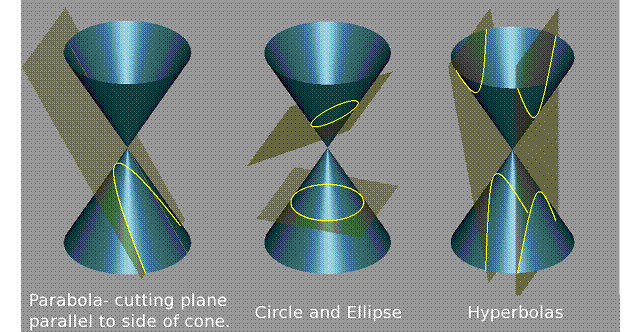
A general term for shapes derived from the cutting of a cone in different ways, in different dimensions.
If you take a hollow cone, and slice through it:
Perpendicular
to its axis, the resulting shape is a circle.
Parallel to
its axis, though offset, the shape is a hyperbola.
Parallel to the face of the cone, the
shape is parabola.
At an angle
to the axis, and offset from the vertex, the shape is an ellipse.
If we then spin these shapes about their central axis, we form surfaces of rotation.
A
SPHERE results from spinning a circle about its axis.
A HYPERBOLOID
results from spinning a hyperbola about its axis.
A PARABOLOD
results from spinning a paraboloid about its axis.
An ELLIPSOID
results from spinning an ellipse about an axis.
These four surfaces from the basis for many reflecting telescope designs - but that’s getting ahead of the tour.
The opening that limits the amount of light entering an optical system. The APERTURE STOP is a mechanical or optical element introduced into an optical system to limit the amount of light that enters it. For telescopes, the APERTURE is the wider of the opening at the entrance of the scope, or the diameter of the objective (be it a mirror or lens). The APERTURE STOP can be a mask placed over an optical tube to reduce the aperture, or an annulus introduced somewhere in the optical train to limit the field of view (as in eyepieces), or other reasons.
A mechanical element introduced into an optical system to prevent or reduce reflected light inside the tube from falling on the objective.
An optical system using both refractive (LENS) and reflective (mirror) elements. All Cassegrain telescopes and their derivatives are Catadioptric systems. You’ll have to wait to find out about those.
Typically a term used with eyepieces, it is the lens closest to your eye, oddly enough. It is the last lens in the optical system that is the eyepiece; at the other end is the FIELD LENS.
The first lens in a telescope or eyepiece. In a refractor, the FIELD LENS is the objective (unless you own an NP101 or NP127, but that’s another lecture). In an eyepiece, the FIELD LENS is the bottom lens of the eyepiece.
The general term for applying some sort of anti-reflective material to the inside of an optical tube, be it a focuser, eyepiece barrel or main tube of your Newtonian. Typical flocking materials are felt, flat black paint, crushed walnut shells painted black, or the skin of the velveteen rabbit.

The distance from a lens or mirror to its focus, that is, where the light is concentrated for a converging lens or mirror. For diverging systems the focus is virtual in that it lies at the vertex of the rays is they were extend away from the direction of propagation.
This is an important optical variable for any optical system. Systems of optics also have focal lengths, which is not necessarily the same as the tube length. The FOCAL LENGTH of a system is the unfolded distance from the focus to an objective of equivalent power as the optical system. For instance, for refractors, the tube length is roughly the same as the FOCAL LENGTH, as the optical path is unfolded. However, Cassegrain telescopes have 2 (or more) optical elements with power and the optical path is folded, so the tube is much shorter than the FOCAL LENGTH.
The ratio of an optical system’s FOCAL LENGTH to its APERTURE. In photography, it is also called the “f-stop,” denoted f/# where # is the FOCAL RATIO. In astronomy, it is a somewhat arbitrary term that has little significance for casual observers. It can be used as a short hand for the scope’s aperture and focal length, for instance Causland’s 61 is a 24” f/4.2 Newtonian, meaning it has a FOCAL LENGTH of 24 x 4.2 = 96” or 2570mm.
The EXIT PUPIL is a function of a scope’s FOCAL RATIO. A scope’s sensitivity to collimation is also a function of the FOCAL RATIO.
Not to be confused with a BAFFLE, a SHROUD is a device mounted to the outside of a scope to minimize light from other sources than the object in question. Truss Newtonians generally have shrouds while refractors have BAFFLES.
The field in question is actually the FOCAL PLANE, or the plane at the FOCUS of an optical instrument. For photography, this plane is in fact planar (flat), but some optical systems give curved FOCAL PLANES. In fact, most telescopes have some degree of FIELD CURVATURE. It is sometimes called Petzval FIELD CURVATURE, as the plane where the image falls is called the PETZVAL SURFACE. Normally, when referred to as an aberration, the curvature is consistent across the image, or rotationally symmetric about the optical axis.
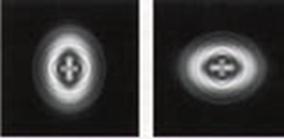
This is a particular form of field curvature where the field of view is curved differently for rays of light entering the system at different orientation. With regard to telescope optics, ASTIGMATISM comes from a mirror or lens having a slightly different FOCAL LENGTH when measured in one direction across the image plane, than when measured perpendicular to that direction.
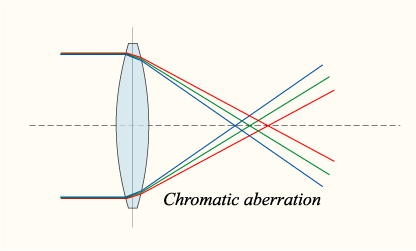
This aberration results from different colors coming to focus at different points. All lens have some degree of CHROMATIC ABERRATION, but others are more corrected for it (or properly, corrected for more colors) than others.
ACHROMATIC lenses involve at least two colors coming to a common focus. ACHROMATIC refractors are typically corrected to have green, and either red or blue come to common focus, neglecting the violet. This leads to those bright violet or blue halos around Vega or the moon, as the green and red colors are coming to focus, but since the violet or blue are not, those colors are out of focus and blurred.
APOCHROMATIC lenses are more difficult to define, and much disinformation is spread in the literature. If a lens is APOCHRMATIC, it should have number of aberrations corrected with regard to color. ACHROMATIC lens may have 2 colors coming to a focus; an APO must have at least 3 colors (typically including violet) coming to a common focus. However, such complex aberrations as SPHEROCHROMATISM (variation in SPHERICAL ABERRATION with different colors) must be controlled. All in all, it is a complicated subject that I leave to the experts....
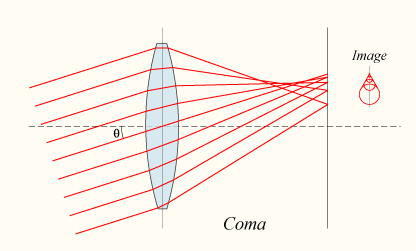
This is an off-axis aberration, that is, only objects (for our purposes, stars) that are not in the middle of the image are affected. The light rays entering the optical system away from the middle at an angle are focused at different points than those entering the optical system on or near the optical axis. This results in a comet-like image being formed away from the middle of the image.
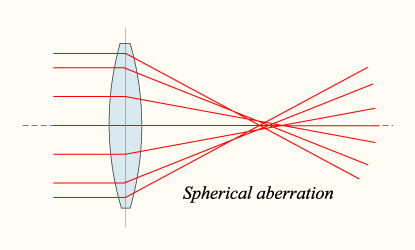
When light rays are reflected by a spherical surface, rays at the very center are focused at a different distance from the mirror than (parallel) rays. In Newtonian telescopes, paraboloidal mirrors are used, as they focus all parallel rays to the same point. However, paraboloidal mirrors suffer from COMA.
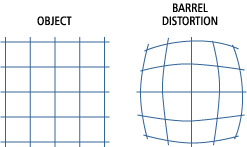
The increase in magnification from the center to the edge of an image. A square ends up looking bloated, or barrel-like.
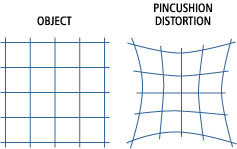
The decrease in magnification from the center to the edge of an image. A square ends up looking pinched, like a pincushion.
Essentially the projection of an out-of-the-field image or light into the field of view. Typically only a problem with poorly BAFFLED eyepieces and bright objects.
The infamous Televue 12mm Nagler Type 2 problem. If your eye is not exactly centered of the FIELD LENS, and perpendicular to the optical axis, part of the image has a black kidney bean blocking part of your view.
Wikipedia (wikipedia.org)
Telescope Optics, Rutten and ven Verooij 1992
Star Testing Astronomical Telescopes, Harold Richard Suiter 2003
Elements of Modern Optical Design, Donald O’Shea 1985
“Defining Apochromatism”, Thomas M. Back 2003, http://tmboptical.com/